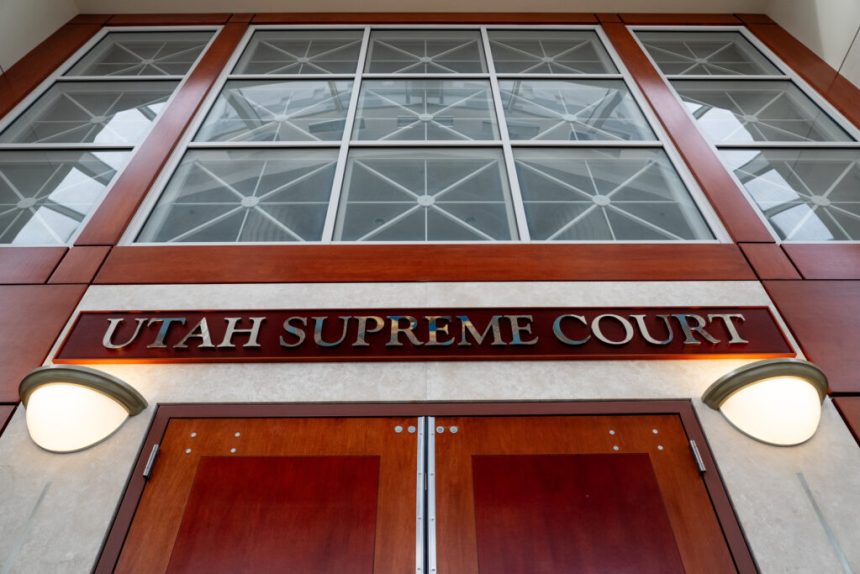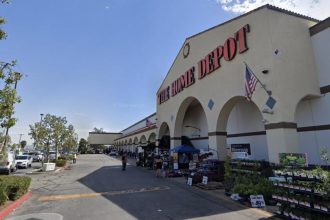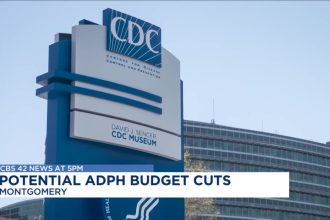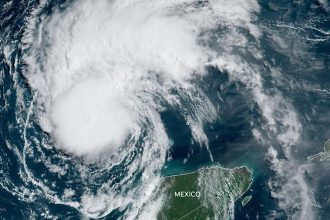The entrance to the Utah Supreme Court inside the Matheson Courthouse in Salt Lake City is pictured on Wednesday, January 3, 2024. (Photo by Spenser Heaps for Utah News Dispatch)
The Utah Supreme Court has denied the Legislature’s petition to block a district court judge’s decision that tossed out the state’s 2021 congressional boundaries and ordered a process to draw a new one.
“For the reasons explained below, we deny Legislative Defendants’ petition,” the Utah Supreme Court wrote in a decision issued Monday.
“Their arguments focus largely on the district court’s remedial process, but they have not appealed from the order putting that process in place,” the order said, adding that instead legislative attorneys challenged 3rd District Judge Dianna Gibson’s denial of their motion to pause the court’s injunction that voided the 2021 congressional map.
“However, their complaints about the remedial process do not demonstrate that the court’s denial of the stay order is legally wrong or that the court otherwise abused its Discretion,” the Utah Supreme Court opinion says. “Without that, they have not shown why they should receive the extraordinary relief they seek here.”
Mark Gaber, an attorney with the Campaign Legal Center which is representing the plaintiffs in the anti-gerrymandering lawsuit, celebrated the ruling in a post on X Monday evening.
“One step closer to a fair congressional map for 2026!” Gaber wrote.
Better Boundaries’ executive director Elizabeth Rasmussen issued a statement applauding the decision.
“Further delay would be in direct opposition to the principles of the Utah Constitution. We’re thrilled this process will move forward on the previously agreed-upon timeline, putting fair congressional maps in place by November 10th,” Rasmussen said. “Utahns will now see the standards they voted for put into practice. That means fewer splits of cities and counties, compact and connected districts, preservation of neighborhoods and communities, and a ban on maps designed to give unfair advantage to politicians or parties.”
While Rasmussen acknowledged legislative defendants’ larger appeal is still pending in court, Monday’s “decision keeps the process moving and affirms the principle that voters, not politicians, choose their representatives.”
Utah’s top Republican legislative leaders, House Speaker Mike Schultz, R-Hooper and Senate President Stuart Adams, R-Layton, said in a joint statement that “a rushed timeline is not the best approach for determining congressional districts nor for setting public policy.”
“Despite this, the Legislature will move forward to the best of its ability,” Schultz and Adams said. “A committee has been formed, the court’s timeline will be followed and Utahns can provide input on the legislative map at redistricting.utah.gov starting Sept. 25.”
Monday’s decision is the latest development in a complex, yearslong lawsuit that has challenged Utah’s redistricting process. Plaintiffs — the League of Women Voters of Utah, Mormon Women for Ethical Government, and several Salt Lake County voters — have alleged that the state’s current congressional boundaries were blatant gerrymandering after lawmakers unconstitutionally repealed and replaced Better Boundaries’ 2018 ballot initiative that sought to create an independent redistricting commission.
Last month, Gibson agreed with the latter claim — that the 2021 Utah Legislature violated the Utah Constitution when it passed SB200, a law that turned that independent redistricting commission into an advisory body that lawmakers could ultimately ignore, which is what they did when the GOP-controlled Legislature enacted the 2021 congressional map.
Gibson ruled that the 2021 map was the result of an unconstitutional process, and ordered it to be “remedied” in time for the 2026 election.
While the Legislature’s attorneys have continued fighting the ruling in court, Utah’s top Republican legislative leaders have begrudgingly said they will comply with Gibson’s ruling and will convene the Legislature to vote on a new map.
Meanwhile, both parties in the redistricting lawsuit have agreed on a timeline for the court-ordered process to enact a new map before Nov. 10, which the lieutenant governor’s office has said is the final deadline for a new map so county clerks have time to finalize their voting precincts in time for January, when 2026 candidates can begin filing to run.
The timeline is as follows, according to court documents:
-
Sept. 25: The Utah Legislature will publish its new proposed map.
-
Sept. 26 to Oct. 5: Lawmakers will hold a public comment period to take input on the map.
-
Oct. 6: The Legislature will take a final vote on the map and submit it to the court for consideration. Plaintiffs will also have the same deadline to submit any proposed maps to the judge.
-
Oct. 17: The deadline for both parties to file briefs, expert reports, and other materials in support or opposition to map submissions, if necessary.
-
Oct. 23 to Oct. 24: The court will hold an evidentiary hearing, if necessary.
-
Oct. 28: The deadline for parties to file proposed findings of fact and conclusions of law with the court, if necessary.
-
Nov. 10: The latest possible date for the court to select a final map, according to the lieutenant governor’s office.
Earlier this month, as legislative defendants’ petition made its way through the Utah Supreme Court, Gibson filed an amendment to her previous, Aug. 25 ruling that officially adopted the timeline while also removing the “order” that required the Legislature to “design and enact” a new congressional map in 30 days.
“That ‘order’ failed to recognize the separation of powers between our courts and our legislature and unintentionally failed to respect the Legislature’s authority to determine how to address the Court’s order enjoining H.B. 2004,” Gibson wrote. “This Court overstepped its authority by ordering the Legislature to enact a new congressional plan.”
However, that doesn’t stop the court-ordered process from playing out to draw a new map, which Gibson ruled was the byproduct of an unconstitutional process. While her ruling allows the Legislature to decide whether to submit a map or not, the court still retains jurisdiction over selecting a new map to be used in the 2026 election — whether it’s submitted by lawmakers or by the lawsuit’s plaintiffs.
Monday’s ruling isn’t the first time the Utah Supreme Court has sided with plaintiffs in the anti-gerrymandering lawsuit.
Last summer, all five justices on the court issued a unanimous opinion sending the case back to district court, ruling that Gibson had erred when she previously dismissed the claim that the Legislature violated the constitution when it repealed and replaced Better Boundaries’ ballot initiative. That ruling also made clear that the Utah Legislature did not have unfettered power to repeal and replace all types of voter initiatives, but rather must show a “compelling government interest” in order to change “government reform” initiatives.









